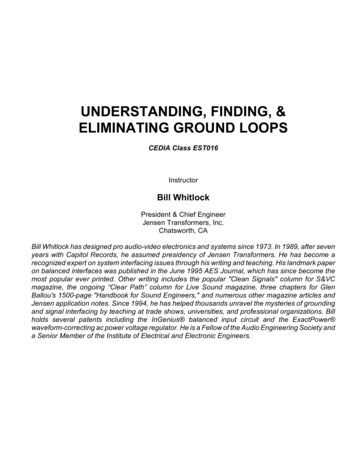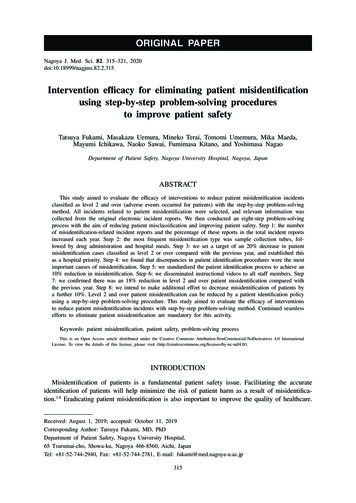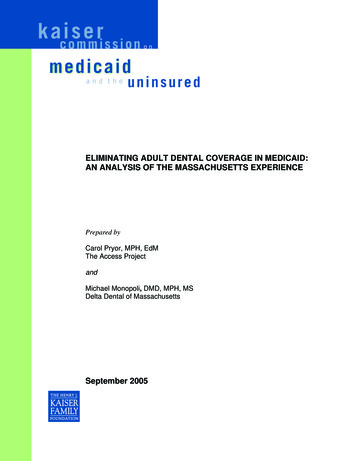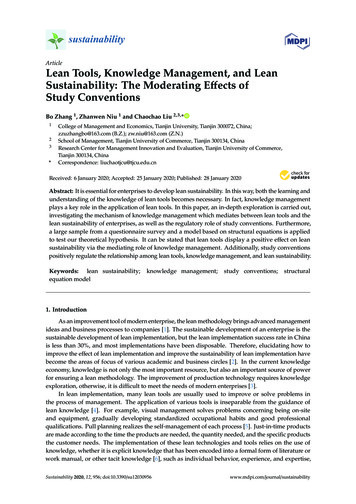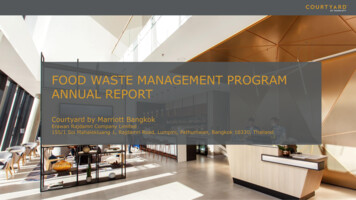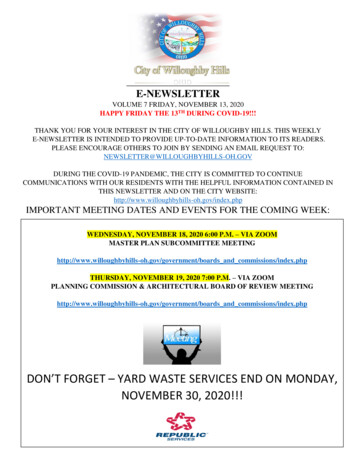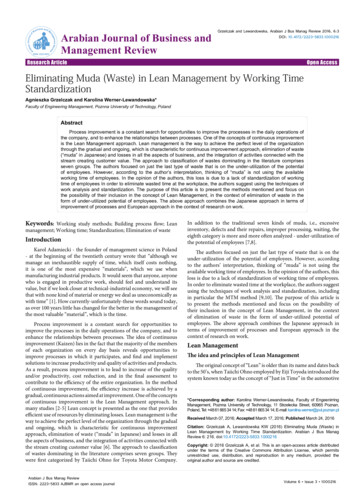
Transcription
AISSN: 2223-5833ent Revgemiewnan Journalbiaofrasssine and MBuaArabian Journal of Business andManagement ReviewGrzelczak and Lewandowska, Arabian J Bus Manag Review 2016, 6:3DOI: 10.4172/2223-5833.1000216Research ArticleOpen AccessEliminating Muda (Waste) in Lean Management by Working TimeStandardizationAgnieszka Grzelczak and Karolina Werner-Lewandowska*Faculty of Engineering Management, Poznna University of Technology, PolandAbstractProcess improvement is a constant search for opportunities to improve the processes in the daily operations ofthe company, and to enhance the relationships between processes. One of the concepts of continuous improvementis the Lean Management approach. Lean management is the way to achieve the perfect level of the organizationthrough the gradual and ongoing, which is characteristic for continuous improvement approach, elimination of waste(“muda” in Japanese) and losses in all the aspects of business, and the integration of activities connected with thestream creating customer value. The approach to classification of wastes dominating in the literature comprisesseven groups. The authors focused on just the last type of waste that is on the under-utilization of the potentialof employees. However, according to the author’s interpretation, thinking of “muda” is not using the availableworking time of employees. In the opinion of the authors, this loss is due to a lack of standardization of workingtime of employees In order to eliminate wasted time at the workplace, the authors suggest using the techniques ofwork analysis and standardization. The purpose of this article is to present the methods mentioned and focus onthe possibility of their inclusion in the concept of Lean Management, in the context of elimination of waste in theform of under-utilized potential of employees. The above approach combines the Japanese approach in terms ofimprovement of processes and European approach in the context of research on work.Keywords: Working study methods; Building process flow; Leanmanagement; Working time; Standardization; Elimination of wasteIntroductionKarol Adamiecki - the founder of management science in Poland- at the beginning of the twentieth century wrote that “although wemanage an inexhaustible supply of time, which itself costs nothing,it is one of the most expensive “materials”, which we use whenmanufacturing industrial products. It would seem that anyone, anyonewho is engaged in productive work, should feel and understand itsvalue, but if we look closer at technical-industrial economy, we will seethat with none kind of material or energy we deal as uneconomically aswith time” [1]. How currently-unfortunately-these words sound today,as over 100 years little has changed for the better in the management ofthe most valuable “material”, which is the time.Process improvement is a constant search for opportunities toimprove the processes in the daily operations of the company, and toenhance the relationships between processes. The idea of continuousimprovement (Kaizen) lies in the fact that the majority of the membersof each organization on every day basis reveals opportunities toimprove processes in which it participates, and find and implementsolutions to increase productivity and quality of activities and products.As a result, process improvement is to lead to increase of the qualityand/or productivity, cost reduction, and in the final assessment tocontribute to the efficiency of the entire organization. In the methodof continuous improvement, the efficiency increase is achieved by agradual, continuous actions aimed at improvement. One of the conceptsof continuous improvement is the Lean Management approach. Inmany studies [2-5] Lean concept is presented as the one that providesefficient use of resources by eliminating losses. Lean management is theway to achieve the perfect level of the organization through the gradualand ongoing, which is characteristic for continuous improvementapproach, elimination of waste (“muda” in Japanese) and losses in allthe aspects of business, and the integration of activities connected withthe stream creating customer value [6]. The approach to classificationof wastes dominating in the literature comprises seven groups. Theywere first categorized by Taiichi Ohno for Toyota Motor Company.Arabian J Bus Manag ReviewISSN: 2223-5833 AJBMR an open access journalIn addition to the traditional seven kinds of muda, i.e., excessiveinventory, defects and their repairs, improper processing, waiting, theeighth category is more and more often analyzed - under-utilization ofthe potential of employees [7,8].The authors focused on just the last type of waste that is on theunder-utilization of the potential of employees. However, accordingto the authors’ interpretation, thinking of “muda” is not using theavailable working time of employees. In the opinion of the authors, thisloss is due to a lack of standardization of working time of employees.In order to eliminate wasted time at the workplace, the authors suggestusing the techniques of work analysis and standardization, includingin particular the MTM method [9,10]. The purpose of this article isto present the methods mentioned and focus on the possibility oftheir inclusion in the concept of Lean Management, in the contextof elimination of waste in the form of under-utilized potential ofemployees. The above approach combines the Japanese approach interms of improvement of processes and European approach in thecontext of research on work.Lean ManagementThe idea and principles of Lean ManagementThe original concept of “Lean” is older than its name and dates backto the 50’s, when Taiichi Ohno employed by Eiji Toyoda introduced thesystem known today as the concept of “Just in Time” in the automotive*Corresponding author: Karolina Werner-Lewandowska, Faculty of EngeenirringManagement, Poznna University of Technology, 11 Strzelecka Street, 60965 Poznan,Poland, Tel: 48 61 665 34 14; Fax: 48 61 665 34 14; E-mail: karolina.werner@put.poznan.plReceived March 07, 2016; Accepted March 17, 2016; Published March 24, 2016Citation: Grzelczak A, Lewandowska KW (2016) Eliminating Muda (Waste) inLean Management by Working Time Standardization. Arabian J Bus ManagReview 6: 216. doi:10.4172/2223-5833.1000216Copyright: 2016 Grzelczak A, et al. This is an open-access article distributedunder the terms of the Creative Commons Attribution License, which permitsunrestricted use, distribution, and reproduction in any medium, provided theoriginal author and source are credited.Volume 6 Issue 3 1000216
Citation: Grzelczak A, Lewandowska KW (2016) Eliminating Muda (Waste) in Lean Management by Working Time Standardization. Arabian J BusManag Review 6: 216. doi:10.4172/2223-5833.1000216Page 2 of 11industry. However, the term “Lean Production” was used for the firsttime - only in 1988 - by John Krafcik - one of the researchers at theInternational Motor Vehicle Program, and was popularized in the book“The Machine That Changed the World”, written by J.P. Womack, D.Jonesand D. Roos. Hence, Lean Management is a management concept,creating such a work culture at a company that makes all employeesstrive to continuously reduce costs, improve the quality and shortendelivery cycle to maximally meet customers’ expectations and adapt tothe environment by eliminating any waste identified [11].The concept of Lean Management is based on certain assumptionsthat Polish author Z. Martyniak [12] called principles, and Germanauthors F. Gendoand and R. Konschaka [13] refer to as components.The following chapter is a brief description of the basic principles ofLean approach.Teamwork stems from the conviction that the performance of theteam is better than the performance of individual employees (becauseof synergy effect). The tasks and responsibilities are delegated to theteam, together with the decision-making autonomy. The result is alimitation of the direct control by the supervisor for self-control. Theseassumptions relate to the activities aimed at the humanization of workand the autonomy of the group, because the greater autonomy of thegroup, the greater the motivation and willingness to work representedby group members.Personal responsibility is mainly reflected in the fact that thegoal is the transfer of responsibility to direct tasks performers, thereby resulting in increasing the autonomy, responsibility for the teamand self-control. When the goal is achieved, decisions are taken atthe lowest level of the organizational structure. A prerequisite for theimplementation of this principle is to raise the level of qualificationof contractors to allow for making effective and efficient decisions.With a flat organizational structure it is easier to coordinate activities,communication runs smoothly and interest in the client is growing.Feedback on Lean Management assumes that even in the conditionsof the continuous work (production lines) the creative potential ofworkers can be unleashed. The starting point of this transformationis to bring diverse information to the executive level. Detailedinformation on the results achieved by the individual employee reachesthe recipients in the spectacular way, and thanks to a feedback benefitsin perfection of the tasks performance.Pro-customer orientation should be the idea, all the employees ofthe company live for: from management to employees at the productionline. In order to tie the customer with products of the company, itis necessary to be sensitive to customers’ wishes and listen to theircomments. Meeting the desires of the client begins with the supplier, sothe suppliers should also be convinced of the importance of the client.Priority of the value added is created not only by the time takento manufacture the product, technical knowledge used during theconstruction or the materials from which the component parts weremade of, but also the demands of the market resulting from the needsof potential customers. Value of the product in general depends on thesubjective assessment of the customer and the market conditions inwhich it is distributed. Less emphasis is placed on quality control ofalready complete do semi-finished products while error-free performanceof their manufacturing process is essential.Work standardization is a tool for keeping work productivity,quality and safety at a high level and it covers the following three aspects:working time, the sequence of work and work in progress (WIP)inventory. Job Rotation is typical for Lean Management: employeesArabian J Bus Manag ReviewISSN: 2223-5833 AJBMR an open access journaltake a kind of journey through various workstations associated with themanufacturing of the product. To facilitate this move from one stationto the other, standardization of the operation is used.Continuous Improvement is to avoid extravagance and waste(in Japanese referred to as “muda”). Activities that do not bring thevalue added are considered wasteful. Among all the concepts andmethods used in Lean Management, without doubt the most frequentlycited is the concept of “Kaizen” which is the process of continuousimprovement. Each process can be further improved, so that wasteoften unnoticed - was eliminated.Rapid elimination of the causes of errors (at source) lies in the factthat one should not settle for superficial reasons for finding defects,poor quality, shortages, etc. Detecting and eliminating errors costs leastwhen done at the place of origin, and is the most expensive and theclient. That is why, all the employees should be involved in detectingand eliminating. The tool commonly used in this area is the method of“5 times ask “why?””.Predicting in the concept of Lean Management is manifested bythe fact that much care is taken to ensure that the employees countedfor operational level staff take part in planning of future activities(decentralization of decision). Preparation of decisions implies notonly the use of the knowledge contained in the written word andfigures, but also the experience of operators and lower management,which often takes the form of “emotional arguments”.Gradual (simultaneous) improvement lies in the fact that thetraditional product development process is replaced with simultaneousprocess (concurrent), so that at the same time the concept is beingdeveloped, product planned, production planned and manufacturingprocess performed. This saves time, which is an important factor incompetitiveness.Importance of Lean Management in a contemporary companyIn order to see how the concept of Lean Management is seen inpractice, the research was conducted to see the importance of thismanagement concept for the company. The research was conductedwith use of a questionnaire. The population analyzed consisted ofemployees in the Wielkopolska region (Poland). The sample size was1200 people, and the results obtained from 1050 respondents wereanalyzed. The sampling method was random, and the study wasconducted in March and April of 2015. The first question concernedthe assessment of the significance of the above listed principles of LeanManagement for the modern enterprise. The results are shown in thediagram (Figure 1).According to the results of the research, the respondents identifiedrapid elimination of errors (84.95% of responses is important) as themost important principle of Lean Management for contemporarycompany, continuous improvement (75.71%) and customer orientation(72.81%) were also at the top of the list. The research confirm theimportance that companies nowadays attach to the relationship withthe client on the one hand, and improving internal business processeson the other. It is interesting, however, that the respondents indicatedthe three principles of Lean Management as those which are notrelevant or their importance is small. These are: the priority valueadded (46.57% believe that it has small importance, and 21.52% - thatdoes it is not relevant at all), standardization (respectively 36.19% and16.19%) and feedback (43.90 % and 10.57%). These responses can becaused by respondents’ lack of understanding of importance of theseconcepts for contemporary company.Volume 6 Issue 3 1000216
Citation: Grzelczak A, Lewandowska KW (2016) Eliminating Muda (Waste) in Lean Management by Working Time Standardization. Arabian J BusManag Review 6: 216. doi:10.4172/2223-5833.1000216Page 3 of 11The second question was based on the identification of the mostimportant principles of Lean Management for the company, whichemploys the respondent. The results are shown in the graph (Figure 2).Analysis of the results obtained leads to the conclusion that theviews of the respondents are consistent. As the most important principleof Lean Management for a company in which the employee works, theyindicated pro-customer orientation (23.81% of responses). Among theleast important principles the employees indicated: feedback (2.83%),the priority of the value added (3.81%) and prediction (3.81%).During the analysis of the data, the results were divided withthe hierarchy criterion, into two groups, the ones obtained fromrespondents who work in management positions and the ones comingfrom operational positions. The results are shown on the next twographs (Figures 3 and 4).The results obtained from the employees at operational levelconfirm earlier results of the research. The vast majority of employeesare deemed that the most important principle of Lean Management, isnow-a-days rapid elimination of errors (84.38% of responses indicatingthe highest importance) remembering that detecting and eliminatingerrors costs least in the place of origin, while is the most expensiveat the client’s. In the case of three principles: the priority of the valueadded, the feedback and the standardization, the results of the surveywere split almost in half: 40-45% of respondents believe that theyhave large importance and 40-43% that it is of little importance forcontemporary companies.The analysis of results of survey among employees working atmanagerial level is far more interesting. They, as the most importantnowadays, recognize the following principles of Lean Management:continuous improvement (91.82% of respondents think that isimportant) and the rapid elimination of errors (86.82% respectively).The study therefore confirms managers awareness that each processcan be further improved, and thus waste and resulting errors at thesource - often invisible - can be eliminated. It is worth noting thatnone of the respondents indicated the principles of Lean Management,which would be completely irrelevant, which may prove the awarenessof managers as to the value and importance of this conception acontemporary company.KaizenThe Kaizen idea and types of wastesIn Japanese “Kaizen” means continuous improvement, improvement,which applies to all, both managers and employees. Kaizen is aphilosophy of management, in the centre of which is a continuous,systematic and implemented step by step improvement that takesplace with the involvement of all employees [14]. It is also a tool forindividual workers to organize and manage their own work. Leadingto standardization which introduces reproducibility and order in thegradual improvementpredictingrapid elimination of errorscontinuous improvementabsolutely not importantstandardizationnot importantpriority of the value addedhas little importancepro-customer orientationhas large importancefeedbackpersonal responsibilityteam work0%20%40%60%80%100%Figure 1: Importance of Lean Management principles according to employees (N 1050).team work4%7%9%personal responsibility13%feedback16%pro-customer orientation13%priority of the value addedstandardization7%24%3%continuous improvementrapid elimination of errors4%predictinggradual improvementFigure 2: The most important Lean Management principle according to employees (N 1050).Arabian J Bus Manag ReviewISSN: 2223-5833 AJBMR an open access journalVolume 6 Issue 3 1000216
Citation: Grzelczak A, Lewandowska KW (2016) Eliminating Muda (Waste) in Lean Management by Working Time Standardization. Arabian J BusManag Review 6: 216. doi:10.4172/2223-5833.1000216Page 4 of 11gradual improvementpredictingrapid elimination of errorscontinuous improvementabsolutely not importantstandardizationnot importantpriority of the value addedhas little importancepro-customer orientationhas large importancefeedbackpersonal responsibilityteam work0%20%40%60%80%100%Figure 3: Importance of Lean Management principles according to employees at operational level (N 640).gradual improvementpredictingrapid elimination of errorscontinuous improvementabsolutely not importantstandardizationnot importantpriority of the value addedhas little importancepro-customer orientationhas large importancefeedbackpersonal responsibilityteam work0%20%40%60%80%100%Figure 4: Importance of Lean Management principles according to employees at managerial level (N 220).work performed. This allows employees to identify problems easily anddevelop appropriate solutions [11].According to the concept of Lean Management, company’sobjective is to seek to identify and completely eliminate or at leastminimize any activities that do not add value to the product orservice. According to P. Drucker, “there is nothing more senselessthan the smooth implementation of the operations, which shouldnot be performed at all” [15]. Activities generating value added forthe customer are those for which the customer is willing to pay, andany action non-value adding from the point of view of the customerand operations absorbing too much of the resources in relation to theeffects and the values they generate, are treated as waste [16]. TaiichiOhno (1988) lists seven types of waste (in Japanese “muda”) [16].Unnecessary transport is due to too long distances between thevarious stages of the production process. Thus, movement of materials,WIP and finished goods requires the involvement of means oftransport, which is associated with additional costs, loss of time andgenerating damage during transport process.Arabian J Bus Manag ReviewISSN: 2223-5833 AJBMR an open access journalWaiting times are associated with the occurrence of “bottlenecks”. Inthis case, employees are not doing their work, as they are unproductivelywaiting for the components coming from the previous production phase,and waiting does not bring added value.Overproduction is the result of production planning that predictingthe level of defects, absence of employees or equipment malfunctions,programs the level of production higher than what the market demands.Improper processing is the result of poor design of productionlines or incorrect selection of the technologies used, and also extendsthe working time required to produce a particular finished product.Production and repair of defects are associated with advancedautomation of production processes and are the result of producingthe batch of defective products. Repairing such products generates highcosts, employs people without adding value to the customer.Surplus inventories are closely linked with the problem of overproduction.Finished goods, work in progress or materials remaining in the company asinventories do not provide any value, what is more - generate highstorage costs, as well as cause the funds freezing (cost of capital).Volume 6 Issue 3 1000216
Citation: Grzelczak A, Lewandowska KW (2016) Eliminating Muda (Waste) in Lean Management by Working Time Standardization. Arabian J BusManag Review 6: 216. doi:10.4172/2223-5833.1000216Page 5 of 11Unnecessary movements are due to poor organization ofproduction and jobs. Workers producing in such conditions carryunnecessary movements and needlessly move parts or components,without adding any value with these activities.In addition to these seven types of waste, the eighth category isincorporated more and more often, namely the one relating to thehuman factor - under-utilization of the potential of employees [6,17].Elimination of waste in a contemporary companyThe research discussed earlier (see. Section 2.2) was not only onLean Management concept, but also on the different types of wastein the enterprise and the need to eliminate them in a contemporarycompany. The third question concerned the assessment of thesignificance of the types of waste above listed for a contemporarycompany. The results are shown in the graph (Figure 5).According to the results of the research, the respondents believethat the most important type of waste that needs to be eliminatedin contemporary companies is unnecessary transport (84.57% ofresponses “necessary to eliminate”), as well as improper processing(84.48%) and under-utilization of the potential of people (82.19%),followed by: unnecessary movements and waiting times. Thefact that such a large percentage of respondents (almost 40%)indicates the types of waste that are not relevant to contemporarycompanies, and they are: overproduction (39.81% of responses“does not matter”, and 9.90% “do not have to eliminate”), excessiveinventories (38.38% and 21.24%) and defects and their repair(29.04% and 13.81%) is worth noticing. This may indicate either alack of awareness of the hidden type of waste or the fact that manycompanies have eliminated these losses, using the principles of JITand TQM.The fourth question was the identification of the type of waste,elimination of which is the most important for the company, whichemploys the respondent. The results are shown in the chart (Figure 6).Analysis of the results of obtained leads to the conclusion that themost important type of waste to be eliminated in the enterprise is underutilization of the potential of employees (16% of respondents indicatedthat type). The research therefore confirms the thesis so importantthese days when so much attention is paid to the qualifications andcompetences of employees. In the coming years learning organizationwill be gaining its importance, resulting in greater attention of managerspaid to the use of the capacities and knowledge of workers.The data analyzed was divided according to the function criterion.The following groups were identified: the results which were obtainedfrom respondents who work in production, trade and service andadministrative units. The results are shown on the next three graphs(Figures 7,8 and 9).Analyzing the detail data obtained on the basis of research onvarious fields of activities of the surveyed companies, the consequence isnoticed. Namely, according to employees of manufacturing companies,the most important type of waste that must be eliminated is unnecessarytransport (96.41% of responses) and under-utilization of the potentialof employees (83.87%), followed by unnecessary movements (79.57%of responses), and improper processing (79.57%). Research suggests,therefore, the need for working routines optimization. And herecomes the huge field of possibilities for improving the work - andunder-utilization of the potential unnecessary movementssurplus inventoriesproduction and repair of defectsno need to eliminateimproper processingnot relevantoverproductionit is necessary to eliminatewaiting timesunnecessary transport0%20%40%60%80%100%Figure 5: Importance of waste types for employees (N 1050).6%7%36%9%16%7%16%unnecessary transportwaiting timesoverproductionimproper processingproduction and repair of defectssurplus inventoriesunnecessary movementsunder-utilization of the potential 3%Figure 6: The most important type of waste according to employees (N 1050).Arabian J Bus Manag ReviewISSN: 2223-5833 AJBMR an open access journalVolume 6 Issue 3 1000216
Citation: Grzelczak A, Lewandowska KW (2016) Eliminating Muda (Waste) in Lean Management by Working Time Standardization. Arabian J BusManag Review 6: 216. doi:10.4172/2223-5833.1000216Page 6 of 11thereby eliminating waste - with the use of methods of testing andstandardization of work.The same research conducted among employees of trading andservice companies also indicates that the most important type of wasteto be eliminated is the under-utilization of the potential of employees(83.45% of indications that it is necessary to eliminate), unnecessarytransport (83.10%) and improper processing (81.03%). In the opinionof respondents for three following factors: excessive inventories(25.86% of responses), defects and their repair (21.89%) and overproduction (13.38%) do not have to be eliminated, which results fromthe nature of the trade and service companies surveyed.The results of the survey conducted among employees ofadministrative units show that the most important type of waste,which is necessary to eliminate is the improper processing (90.00% ofresponses), unnecessary transport (86.88%) and waiting times (79.38%).Hence, the conclusion is that not only in manufacturing but also inadministrative units and trading and service companies measures mustbe taken to analyze the organization of human labor and the use ofworking time, probably because there are enormous reserves hidden,where waste can be transformed into the value added. In the opinionof respondents the three following factors: the overproduction (50.00%of responses), excessive inventory (43.75%) and defects and theirrepair (36.25%) do not matter, because of the nature of administrativeoperations.Analysis and standardization of workAnalysis and standardization of work as a work organizationimprovement factorOne of the key factors to improve the organization of work istechnical standardization of work, i.e., the determination of the optimaleffort to perform a working task in certain organizational and technicalconditions. Practically speaking, the standardization work is a set ofactions leading to the determination of labor standards, which is theamount of time necessary and sufficient so that a specified operationwas performed by the employee (or a team) [18]. This is done byanalyzing the relationship between the various components of workingtime and work organization and working methods, the characteristicsof the technological process and workstations equipment, as well astaking into account the principles of ergonomic design of workplaces.At the same time standardization of work provides an output datanecessary to [18]: proper assessment of the level of organization of work, determining the conditions and possibilities for furtherimprovement of labor efficiency, assessing the level of costs of production, improving the management organization, improving working conditions,under-utilization of the potential unnecessary movementssurplus inventoriesproduction and repair of defectsno need to eliminatenot relevantimproper processingit is necessary to eliminateoverproductionwaiting timesunnecessary transport0%20%40%60%80%100%Figure 7: Importance of waste types according to respondents employed in production companies (N 279).under-utilization of the potential unnecessary movementssurplus inventoriesproduction and repair of defectsno need to eliminatenot relevantimproper processingit is necessary to eliminateoverproductionwaiting timesunnecessary transport0%20%40%60%80%100%Figure 8: Importance of waste types according to respondents employed in trade and services companies (N 533).Arabian J Bus Manag ReviewISSN: 2223-5833 AJBMR an open access journalVolume 6 Issue 3 1000216
Citation: Grzelczak A, Lewandowska KW (2016) Eliminating Muda (Waste) in Lean Management by Working Time Standardization. Arabian J BusManag Review 6: 216. doi:10.4172/2223-5833.1000216Page 7 of 11under-utilization of the potential unnecessary movementssurplus inventoriesproduction and repair of defectsno need to eliminatenot relevantimproper processingit is necessary to eliminateoverproductionwaiting timesunnecessary transport0%20%40%60%80%100%Figure 9: Importance of waste types according to respondents employed in administrative units (N 160). developing and applying appropriate motivation employees.The standard technically justifi
Lean Management The idea and principles of Lean Management The original concept of “Lean” is older than its name and dates back to the 50’s, when Taiichi Ohno employed by Eiji Toyoda introduced the system known
